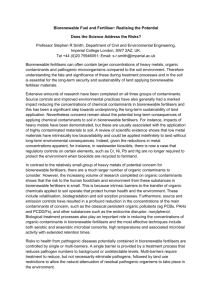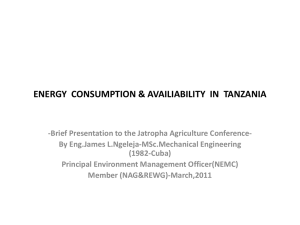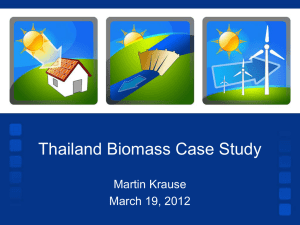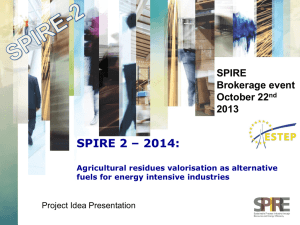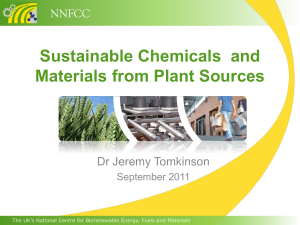Introduction to biorenewable resources
advertisement
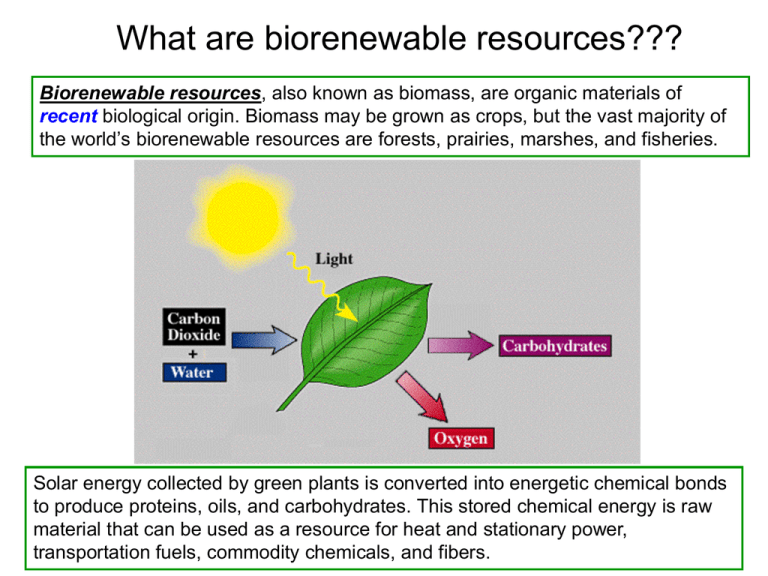
What are biorenewable resources??? Biorenewable resources, also known as biomass, are organic materials of recent biological origin. Biomass may be grown as crops, but the vast majority of the world’s biorenewable resources are forests, prairies, marshes, and fisheries. Solar energy collected by green plants is converted into energetic chemical bonds to produce proteins, oils, and carbohydrates. This stored chemical energy is raw material that can be used as a resource for heat and stationary power, transportation fuels, commodity chemicals, and fibers. What are biorenewable resources??? Biorenewable resources are by definition sustainable natural resources. Sustainable implies that the resource renews itself at such a rate that it will be available for use by future generation. Switch Grass Deforestation of Amazon Bioenergy and Bio-based Products Transportation Fuels Electrical Power Chemicals Natural Fibers Biorenewable Resource Utilization Before Industrialization Silkworms Charcoal Biorenewable resources were the predominant source of energy, organic chemicals, and fibers in the human history as recently as 150 years ago. 5,500 Years-Old Winery Decline of Biobassed Products ? An Energy Dependent Society Internet Micro-processor Modifiers Environmental issues N uc lea r Satellite Energy Usage WWII WWI Telecommunications Coal Steam Steam Power locomotive stations ns o b r a Hydroc Air travel Internal combustion engine 1750 1800 1850 1900 Living standards Population Global growth markets Drivers 1950 2000 Driving Force for Change: Less Expensive & More Cook and Sheath, 1997 Easily Manipulated Feedstock Petroleum & Fossil Resources-Based Industry 1859 - Drake Well, Titusville, PA Titusville City Limits Petroleum & Fossil Resources-Based Industry Petroleum & Fossil Resources-Based Industry We live in a fossil fuel society Total Energy Renewable Energy Wind, 5% Renewable, 7% Solar, 1% Nuclear, 8% Petroleum, 40% Transportation Natural Gas, 22% Biomass • Wood waste • Municipal solid waste • Landfill and biogas • Ethanol Biomass, • Biodiesel 53% Conventional Hydroelectric, 36% Geothermal, 5% Coal, 23% Data from EIA 2007 Motivation for Returning to a Bioeconomy •Excess agricultural production: Especially in U.S., but many countries are becoming self sufficient in food production More Electric Platform Fuel Mix for U.S. Electricity Generation in 2005 From EPA website Motivation for Returning to a Bioeconomy •National security: Reduced reliance on foreign cartels Motivation for Returning to a Bioeconomy •Rural development: Rural economies are not thriving in many parts of the world Challenges to Using Biorenewable Resources •Low bulk density –Complicates handling, transport, and storage •High moisture content –Impacts transport and energy demand of processing •Low heating value –Requires large acreage •High oxygen content –Current economy based on hydrocarbons Hydrocarbon Reforming C2H6 + 4H2O 2CO2 + 7H2 3H2 + N2 → 2NH3 H H H C C H H H H2O O=C=O + H-H C2H5OH + 3H2O 2CO2 +6H2 H H H C C H H Ethanol Steam Reforming (ESR) H H H dehydration -H2O OH dehydrogenation -H2 H C coke C H 5H2 + 2CO2 H O C C steam reforming +3H2O H H CH4 + CO decomposition acetaldehyde Renewable Hydrogen from Bio-ethanol ??? Surface intermediates Defining the Resource Base • Wastes –Agricultural residues (cornstover, wheat straw, bagasse) –Yard waste –Municipal solid waste (MSU) –Food processing waste (grain hulls) –Manure Defining the Resource Base • Dedicated crops –Conventional crops (corn and soybeans) –Herbaceous crops (grasses) A herbaceous plant is a plant that has leaves and stems that die down at the end of the growing season to the soil level –Woody crops (poplar trees) Composition of Biorenewable Resources • Basic building blocks –Protein –Oils –Sugar –Starch –Lignocellulose (fiber) Lignocellulose: Future Feedstock • Structural material of most plants • Polymeric composite consisting of: –Cellulose (polysaccharide of glucose) –Hemicellulose (polysaccharide of pentoses and hexoses) –Lignin (phenylpropane-based polymer) • Not easily broken down into simple sugars Cellulose Building blocks for lignin How Much Biomass Could Be Produced? Total potential in U.S. is about 48 EJ (48 x 109GJ)–Could supply 50% of energy demand, or–More than enough to replace all petroleum consumption and organic chemical production Biobased Products: Bioenergy • Process Heat –simplest use of biomass –Drying –Steam raising • Stationary Power –Rankine steam cycle –Brayton gas turbine cycle Biobased Products: Transportation Fuels • Oxygenated fuels derived from biomass are thought to reduce air pollution –Ethanol: simple sugars derived from biomass are fermented to ethanol –Methanol: formed from the catalytic reaction of syngas (which can be produced from gasification of biomass) –Biodiesel: transesterification of vegetable oils (methyl or ethyl esters) Biobased Products: Chemicals • Replacing chemical building blocks produced from petrochemicals • Exploiting biochemistry of plant materials Biobased Products: Plant Fibers •Plant fibers are long, thin cells with walls of lignocellulose •Applications include textiles, papers, and composite building materials •Non-woody fibers also have potential Technologies for Converting Biomass to Biobased Products •Thermal –Combustion (Stoichiometric or excess oxygen) –Gasification (partial combustion) –Pyrolysis (no oxygen) •Biological –Anaerobic digestion (mixed culture) –Fermentation (pure cultures) •Chemical –Pressure and temperature –Catalytic Environmental Performance • Every technology has both positive and negative impacts –Depends upon implementation • Biorenewable resources are no exception –Demand for fuel wood deforested much of Europe –Agriculture blamed for desertification in Africa Economics • Biobased products must be able to compete in markets • Biorenewable resources will not win as traditional “least cost” feedstock • Restrictions on carbon dioxide emissions could rapidly shift advantage to biorenewable resources On a volumetric basis, the heating value of biomass is only 20-50% that of coal
